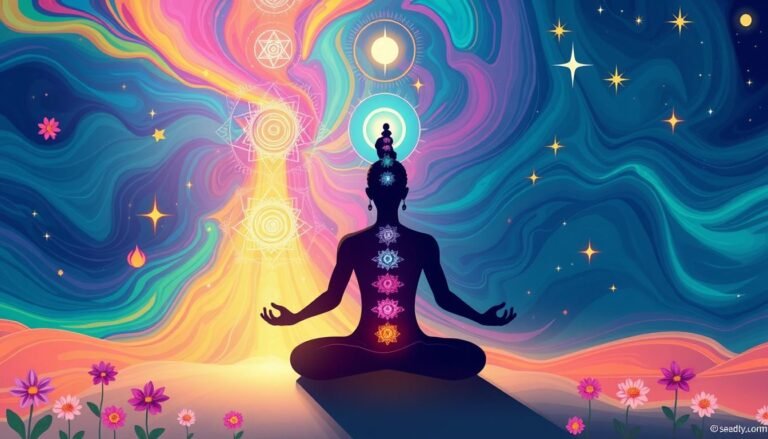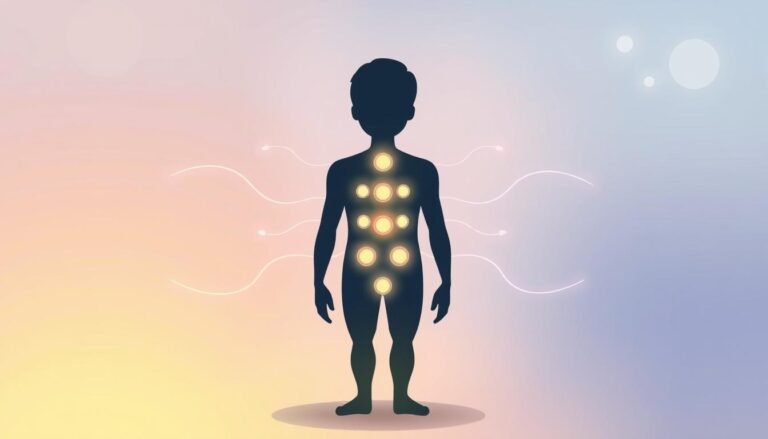Which Energy Healing Methods Are the Most Effective?
“The body is held together by sound. The presence of disease indicates that some sounds have gone out of tune.” Dr. Deepak Chopra’s words highlight the power of energy healing. It can greatly improve our health and well-being.
Energy healing has been around for centuries. It’s a key part of alternative medicine and holistic healing. Today, over 200 methods exist, all trying to balance our energy. They believe that when our energy flow is off, we get sick.
Practices like acupuncture, reflexology, reiki, and qigong offer many ways to heal naturally. Studies show they can be effective. For example, reiki has been shown to reduce pain. Qigong helps teens with depression and anxiety.
We’ll look into the best energy healing methods. We’ll cover their basics, how to use them, and the science behind them. If you’re facing pain, stress, or just want to feel better, learning about these methods could change your life.
Understanding Energy Healing: Principles and Foundations
Energy healing is an ancient practice that uses the subtle energy in our bodies. This energy, called qi in Chinese medicine and prana in Ayurveda, is the core of many healing methods. These methods aim to balance and harmonize our body’s energy field, fixing physical, emotional, and spiritual issues.
The concept of subtle energy in healing practices
Subtle energy is the heart of energy healing. It flows through and around us, affecting our health and happiness. Practitioners use this energy to heal and balance us. The idea of chakras, energy centers along the spine, is key in many energy healing practices.
Historical roots of energy healing across cultures
Energy healing has roots in many cultures. Ancient Egyptians, Chinese, and Japanese developed their own ways to work with life force energy. These practices have grown, but their main idea remains the same: using subtle energy for healing and wellness.
Basic assumptions underlying energy-based modalities
Energy healing is built on several key ideas:
- The existence of an energetic body that interacts with our physical form
- Physical symptoms can arise from disrupted energy flow
- Manipulating subtle energy can activate the body’s self-healing mechanisms
- Balance in the energy field leads to overall health and well-being
Knowing these principles helps us understand energy healing methods and their benefits. Whether it’s acupuncture or Reiki, these practices aim to improve our health and energy by balancing our life force.
Reiki: A Popular and Widely Practiced Energy Healing Method
Reiki is an ancient healing practice that has become popular worldwide. It uses hands-on healing to channel universal energy. This helps promote physical and emotional well-being.
In a Reiki session, which lasts 60 to 90 minutes, the practitioner touches specific points on the body. This touch is believed to transfer healing energy. It helps in relaxation and balance.
- Reiki is offered in over 800 U.S. hospitals
- Sessions cost between $25 and $100
- No formal education is required to start Reiki training
While there’s limited scientific proof, many people find Reiki helpful. It may aid in managing anxiety, depression, and pain. It’s often used alongside traditional medicine.
Reiki has been a transformative experience for me. It helped me find inner peace and manage my chronic pain better than I ever thought possible.
Reiki also involves chakra balancing, focusing on energy centers in the body. Practitioners aim to clear blockages and restore energy flow. This promotes overall health and vitality. Despite the need for more research, Reiki remains a popular holistic wellness approach.
Acupuncture: Ancient Chinese Energy Healing Technique
Acupuncture is a key part of Traditional Chinese Medicine. It uses the body’s energy pathways to heal and balance. Let’s dive into the world of acupuncture and its health benefits.
Meridians and the Flow of Qi
The body has invisible energy paths called meridians. These paths carry qi, the life force. When qi flows well, we stay healthy. But, blockages can cause sickness. Acupuncture tries to keep qi flowing smoothly.
The Process of Acupuncture Treatment
In an acupuncture session, a practitioner puts thin needles into specific points. These points are chosen based on the patient’s health needs. The needles might feel a bit tingly but are usually painless. They stay in for 20-30 minutes to help unblock energy and aid healing.
Benefits and Conditions Treated
Acupuncture helps with many health issues:
- Chronic pain
- Migraines and headaches
- Nausea and digestive problems
- Stress and anxiety
- Respiratory issues
Studies show acupuncture can boost the body’s healing powers. It might affect the central nervous system. Many people find it helpful. Always talk to a doctor before trying acupuncture.
Pranic Healing: Manipulating Life Force for Wellness

Pranic healing uses the idea of prana, our life force, for health. It involves scanning and cleansing the aura to improve overall well-being. Practitioners use their hands to find and fix energy imbalances.
Recent studies show pranic healing’s benefits:
- 70% of participants saw big improvements in health
- 60% found relief from various health issues
- Healing times were 30% shorter than usual treatments
- Stress levels dropped by 40% and emotions became clearer
In a session, the healer scans for energy blockages in the aura. They then clean and energize these spots. This includes balancing the body’s energy centers, or chakras.
“Pranic healing led to enhanced vitality, with a 25% increase in energy levels reported by participants.” – N. H. Mazzotta et al., 2022
Though science is still catching up, many people find pranic healing helpful. It can reduce stress and improve sleep. But, it’s important to keep an open mind and talk to doctors before trying it for health issues.
Quantum Touch: Influencing the Body’s Life Force
Quantum Touch is a powerful energy healing method. It uses breathwork and meditation to create a high-energy field. This helps to stimulate the body’s natural healing abilities.
Principles of Quantum Touch
The core principle of Quantum Touch is energy resonance. Practitioners believe they can raise their energy to influence the client’s field. This process, called entrainment, makes two objects vibrate in sync when energy is shared.
Techniques Used in Quantum Touch Sessions
Quantum Touch sessions involve several key techniques:
- Focused breathing exercises
- Body awareness meditation
- Energy sweeping
- Chakra balancing
These methods aim to create a high frequency of life-force energy. This energy can be directed to areas of pain or stress. The practice is said to benefit both the practitioner and the patient, uplifting the healer rather than draining them.
Potential Benefits and Applications
Quantum Touch has shown promise in various areas:
- Pain relief, including chronic conditions
- Accelerated healing of injuries
- Improved overall well-being
- DNA-level healing effects
Research by Dr. Norman Shealy found that a single Quantum Touch session provided pain relief lasting over a week in chronic patients. The technique has been integrated with other healing modalities like chiropractic care, acupuncture, and Reiki. This enhances their effectiveness through life-force manipulation.
Energy Healing Methods: Comparing Effectiveness and Applications
Energy healing methods vary in their effectiveness for different conditions. A comparative analysis shows that some practices have promising results. For example, Reiki has been shown to help with pain and stress in clinical settings.
Acupuncture is backed by a lot of research and is effective for chronic pain. Pranic Healing and Quantum Touch, though not well-studied, have many success stories. These methods are often used alongside traditional treatments.
“Energy healing is about achieving wholeness in physical, emotional, intellectual, social, and spiritual aspects rather than mere elimination of disease symptoms.”
A 2013 study found that 10-minute Reiki sessions improved shoulder mobility. A 2010 study in the Journal of Alternative and Complementary Medicine showed Reiki reduced pain and anxiety in women having hysterectomies.
- Pranic healing helps with migraines, coughs, fevers, and muscle pains
- Reiki is effective for colds, flu, headaches, and possibly heart disease
- Hospitals and clinics offer energy healing as complementary therapies
Even with mixed research, many people believe in the benefits of energy healing. As more studies are done, we might learn more about their healing power and uses in healthcare.
Sound Healing: Using Vibrations for Energetic Balance
Sound healing is a powerful way to balance and heal. It uses sound frequencies to help us feel better. This ancient practice is becoming more popular as a way to improve health.
Types of Instruments Used in Sound Healing
Sound healers use different tools to create healing sounds:
- Crystal bowls
- Tuning forks
- Tibetan singing bowls
- Gongs
- Drums
Each tool makes unique sounds that resonate with our bodies. For instance, crystal bowls help balance our energy centers. Tuning forks target pain or tension areas.
The Science Behind Sound Therapy
Studies show sound therapy can greatly improve our health. Sound waves can change our brainwaves, helping us relax and feel less stressed. Binaural beats, heard in each ear, help us meditate deeper and focus better.
Potential Benefits of Sound Healing Sessions
People often feel:
- Less stress and anxiety
- Better sleep
- Less pain
- Clearer mind
- Deeper meditation
In a session, you lie down while a practitioner plays instruments. The sounds envelop you, helping to balance and heal your body and mind.
“Sound healing is like a tuning fork for your body, mind, and spirit. It helps bring you back into harmony.”
Sound healing is great for physical issues or to deepen your spiritual journey. It’s a gentle yet effective way to connect with your body’s healing powers.
Qigong: Ancient Chinese Practice for Energy Cultivation
Qigong is a key part of Traditional Chinese Medicine. It combines movement, breathwork, and meditation to balance energy in the body. This practice has deep roots in Chinese philosophy and martial arts, going back thousands of years.
People use gentle movements, deep breathing, and focused mental states in qigong. This helps improve the flow of qi through the body’s meridians. It’s a holistic way to boost overall well-being and help the body heal itself.
Research shows qigong has many benefits:
- Improved balance and stability
- Reduced stress and anxiety
- Enhanced focus and concentration
- Potential lower risk of chronic diseases
A 2020 study with 95 adults aged 51-96 found big improvements in balance and gait after 12 weeks of qigong. Another study with younger people showed a 16.3% increase in stability scores after 8 weeks.
Qigong is one of the four branches of traditional Chinese medicine, alongside acupuncture, Chinese massage, and Chinese herbology.
While more research is needed, qigong is seen as a safe option for improving health. It’s important to talk to a healthcare provider before starting, especially if you have chronic conditions.
Choosing the Right Energy Healing Method for You
Finding the right energy healing technique can change your life. With many options, it’s key to think about what you need. Let’s look at how to pick the best method for you.
Factors to consider when selecting an energy healing technique
Think about your health concerns and goals when picking a method. Acupuncture is good for pain and stress. Reiki helps with relaxation and balance. Also, consider what you’re comfortable with and if there are skilled practitioners nearby.
Importance of personal resonance and intuition
Listen to your intuition when trying different methods. It can lead you to the right one. Some might like Ayurveda’s ancient wisdom, while others prefer Healing Touch’s modern approach. Remember, what works for one might not work for another.
Combining multiple modalities for comprehensive healing
For a full holistic healing, try mixing different techniques. You could use Reiki with aromatherapy or acupuncture with yoga. This way, you tackle different health areas at once. Start with one, then try others, seeing how your body reacts. Using a variety of healing methods can lead to a healthier, happier life.
Source Links
- 10 Types of Energy Healing: Which One Is Right for You? – LocallyWell
- What Is Energy Healing?
- Energy Medicine: A Detailed Guide | LIVV Natural
- Energy Healing 101 – What You Need To Know | Energy Healing & Holistic Wellness
- What a Reiki Session Feels Like
- What Is Reiki?
- Reiki: What it is, techniques, benefits, risks, and more
- Classical Chinese Medicine Modalities – National University of Natural Medicine – NUNM
- Acupuncture
- Pranic Healing: Technique, How It Works, Application, and Consideration
- Prana and Pranic Healing – Master Your Life Force
- How Does Quantum-Touch Work?
- The Demystification of Hands-On Healing
- Energy Healing Techniques/Methods | Quantum-Touch
- A Consideration of the Perspectives of Healing Practitioners on Research Into Energy Healing
- Types of Energy Healing Techniques by Vantage Point Recovery
- Energy Healing Modalities | Holistic Health Approaches Class Notes
- How Vibrational Sound Therapy Can Restore Balance
- A Guide to Sound Healing
- How To Balance Your Biofield With Sound Healing – SHA Blog
- Qigong Meditation: For Beginners, Techniques, Benefits, and More
- Qigong
- Qigong 101: A Beginner’s Guide to the Art of Cultivating Vital Energy
- Types of Energy Healing
- Choosing Holistic Healing Modalities for Your Practice
- Energy Healing | Mettarel








